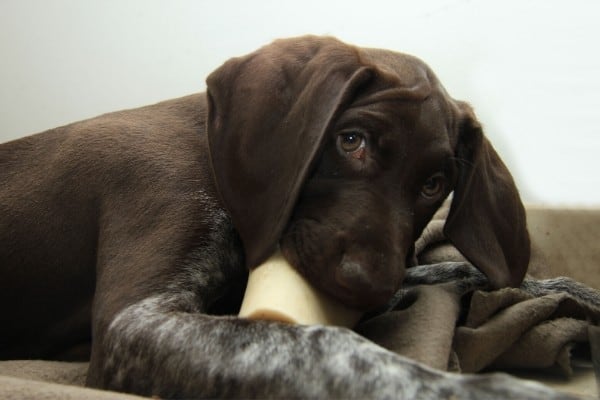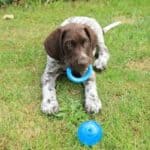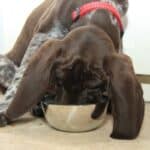The German Shorthaired Pointer is a beautiful family dog who tends to be exceptionally good with kids.
If you’re considering the GSP for your family pet, you may be wondering what will happen if you need to leave them alone.
Can German Shorthaired Pointers be left alone? The GSP can learn to stay home alone, but they are human-focused dogs who prefer to be close to their people, so some may experience anxiety or have trouble with boredom and destructive behavior when left alone.
If you work a full-time job and are considering owning a GSP, one of your first questions will be whether you can leave your dog home alone.
This is everything you need to know about leaving a GSP home alone and what you can do to make the experience easier for both of you.
When Can German Shorthaired Pointers Be Left Alone in the House?
GSPs are relatively slow to mature. Most are not mentally adults until they are 2 years old.
This means that you have about a year of time during which the dog is fully physically mature but still has a puppy-like mind.
For the first two years, it is not realistic for you to expect your GSP to roam the house freely without getting into mischief.
Even if your dog has never caused trouble before, he can suddenly get it into his mind to cause trouble and do a great deal of damage to your home.
Therefore, you should not leave your GSP loose alone in the house until he’s at least 2 years old and has demonstrated the ability to ignore things that he shouldn’t touch.
How Long Can German Shorthaired Pointers Be Left Alone in the House?
Age: 8 weeks to 2 Years
Until your GSP is at least 2 years old, he should be crated or kept in a dog-safe room whenever you leave the house.
Otherwise, you risk your dog getting into something that could be destructive for your home and dangerous for him.
Age: 2 years to 8 Years
While your dog is a responsible adult, you may be able to leave him alone for longer periods.
Provided your GSP gets plenty of exercise, training, and human interaction, you may find that you can leave them alone for an entire eight hour work day or even a bit longer without any trouble.
These are intelligent, highly trainable dogs who are eager to please you. Once they understand what you want them to do in the house, they are unlikely to suddenly behave destructively.
Age: 8 Years and Up
The GSP can live to be 12 years or even older, but many dogs begin to struggle with some old-dog problems around the time they turn 8 years old.
Around this time, your GSP may begin to struggle with incontinence.
This can be very traumatic for dogs since they know that they aren’t supposed to have accidents in the house but can’t hold it.
You may need to start leaving your GSP alone for shorter periods because they won’t be able to hold their urine for long enough.
The GSP and Separation Anxiety
Separation anxiety is common in both pure breeds and mixed-breed dogs, but some breeds may be more prone to it than others.
Dogs who are very tuned in to their people, eager to please, and responsive, like the German Shorthaired Pointer, may be more likely to experience separation anxiety.
Your dog may seem anxious before you leave and be loud or destructive while you’re gone.
Some dogs are so anxious about your leaving that they can show signs of anxiety for hours before you leave and be miserable the entire time you’re gone.
It’s best not to get a GSP if you can’t spend significant amounts of time with your dog and take him with you at least some of the places that you go.
That said, it’s not realistic for most people to spend all of their time with their dog or take their GSP everywhere with them.
You’ll want to train your puppy for success in avoiding separation anxiety.
Start Early
Spend time away from your dog from the beginning.
From the day you bring your puppy home, get them used to spending some time away from you. It’s a good idea to have your dog sleep in a different room than you do.
Begin working your puppy up to spending as much time away from you as you hope to spend away when he becomes an adult.
Start Small
Start with very brief periods and work your way up.
Be careful not to always leave at exactly the same time, but to vary your movements so that your puppy can’t predict when you’ll come and go.
This helps him to get used to you being gone for periods of time unexpectedly.
Avoid very long separations, which may be traumatizing.
When your GSP is fully grown, you may be able to stay late at work and come back to your dog after eight or so hours alone.
However, a longer separation like this when your GSP is developing can be traumatizing and lead to separation anxiety.
Make sure that all of the separations that your puppy experiences from you are relaxed and not stressful.
Start Distraction Techniques
Use food toys from the beginning.
Puppies who grow up enjoying food dispensing toys, like the ever-popular Bob-A-Lot, will develop a healthy obsession with them.
That means that you can give your dog one of these toys, and he will be sufficiently occupied and not worried about you going.
Teaching your dog to love food dispensing toys from the very beginning will make it easier to use them as a pacifier later on when you need to be away from your dog.
How to Make Being Alone Easier for Your Dog
Whether dogs suffer from separation anxiety or not, it’s best to make things as easy on them as possible when you have to leave them alone.
Here are some techniques to make leaving your GSP alone easier, whether you still need to crate him, keep him in a dog-safe room, or if you leave your dog loose in your home.
Exercise First
A well-exercised GSP is much more likely to be okay with spending the day home alone.
It’s best to give your GSP the bulk of his exercise before you leave for work in the morning so that he’ll be willing to relax until the evening walk when you come home.
This is the best time for vigorous exercise such as a run, intensive training session, etc.
Treats and Toys
Food distributing toys are an ideal distraction while you leave your dog home alone. Chew toys that your dog is particularly fond of or treats that take a while to chew are also great options.
If there are any chew toys or other toys that your dog is particularly fond of, it’s not a bad idea to keep it away from him until you leave.
This way, your dog will be very excited to get his favorite toy when you leave and not worry as much about the fact that you’re gone.
Comforts
If your GSP is already showing separation anxiety or you are worried about him developing it, it can help to leave some comforting things around your home to make it easier for him.
Clothing and bedding with your scent on it can be a great comfort to a dog who is experiencing separation anxiety.
You can try using a baby cam or one of the specially designed dog cameras (I recommend the Furbo Dog Camera) to talk to your GSP and even give him treats while you’re gone.
It helps some dogs to leave music or the television on as well.
Related Question:
Does It Help to Have More Than One Dog If You Leave Your GSP Home Alone?
The GSP tends to be a very social dog who loves the company of other dogs.
Some GSPs may show improvement in their anxiety or boredom if they have another dog to play with when they are left home alone.
Other GSPs could care less about the other dog and only care that you are gone. It completely depends on your individual dog, whether another dog can be helpful or not.





